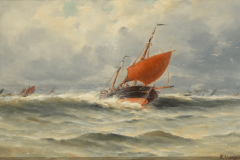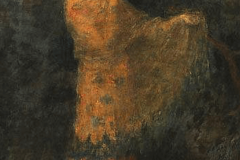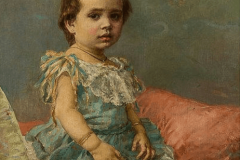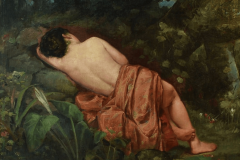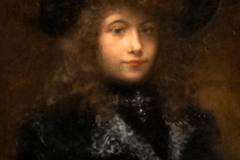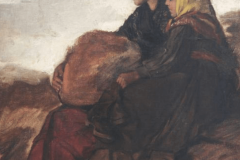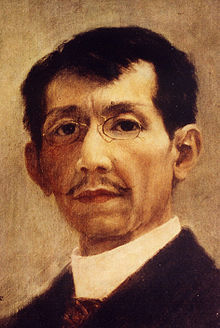
Buying Felix Hidalgo paintings – Highest Prices Paid: Artist Bio & images follow:
FELIX HIDALGO (b. Binondo, Manila, February 21, 1855 d. Sarrea, Spain, March 1913)
Felix R. Hidalgo was the third of seven children of Eduardo Resurreccion Hidalgo, landed proprietor and lawyer, and Maria Barbara Padilla, entrepreneur. He studied in the University of Santo Tomas where his artistry was encouraged by Fr. Sabater. He studied law, which he never finished, received a bacheller en filosifia in March 1871. He was simultaneously enrolled at the Escuela de Dibujo y Pintura under, Spanish painter, Agustin Saez. In 1876, he previewed his “La Barca” (The Native Boat), “Vendadora de Lanzones” (Lanzones Vendor) and other paintings at the Teatro Circo de Bilibid before they were sent to the Philadelphia Universal Exposition of that year. In 1878, he painted the poignant and well-crafted “Los Mendigos” (The Beggars).
In 1877, Resurrección Hidalgo was awarded second place in the contest for best cover design for the de luxe edition of Fr Manuel Blanco’s “Flora de Filipinas” (Plants of the Philippines). In 1879 he left for Spain as a pensionado in fine arts of the Ayuntamiento of Manila. He attended the Real Academia de Bellas Artes de San Fernando de Madrid, whose courses he described in a letter to lose Rizal as obsolete and boring. During this period he exhibited “La Siesta” (Nap in the Afternoon), 1881, a piece which was favorably reviewed in La Ilustracion Espanola y Americana in that year.
In 1879, he went to Rome, still as a pensionado, where he finished a portrait, “Senador Romano” (Roman Senator), and others. In 1883, he toured Spain rejoining his patron and close friend, Francisco de Yriarte in Galicia. There, he pitched a tent to study nature more closely. He then moved to Paris for further studies with the partial support of de Yriarte.
His “Las Virgenes Cristianas Expuestas al Populacho” (The Christian Virgins Exposed to the Populace), was awarded the ninth silver medal at the 1884 Exposicion General de Belles Artes in Madrid. This showed a Group of boorish looking males mocking semi-naked female slaves, one of whom is seated in the foreground, with her head bowed in misery. In the same exposition Luna’s “Spoliarium” was awarded a gold medal.
In the Exposicion General de las Islas Filipinas in Madrid in 1887, Resurreccion Hidalgo presented “La Barca de Aqueronte” (The Boat of Charon),1887, and “Laguna Estigia” (The Styx), 1887, for which he received a gold medal. La barca was again shown at the Exposition Universelle de Paris and was awarded a silver medal by an international jury. In 1891 it was accorded a diploma de honor at the Exposicion General de Bellas Artes of Barcelona. This painting also received a gold medal in the international exposition of fine arts in Madrid during the commemoration of the 400th anniversary of the discovery of America. It was finally bought for 7500 pesetas by the Spanish government and ordered hung in the principal saloon of the Museo-Biblioteca de Ultramar, passing afterwards to the Museo de Pinturas de Madrid after the archipelago became a territory of the United States.
Hidalgo exhibited “Adios al Sol” (Farewell to, the Sun), 1891. at the Exposicion internacional de Bellas Artes in Madrid in that year and “El Crepusculo” (The Dawn), 1893, at the Universal exposition Chicago, also in that year. He showed both again at the Exposicion Artistica de Bilbao in August 1894. In the Exposicion Regional de Filipinas in Manila in January 1895, Resurreccion Hidalco was represented by paintings executed in the grand romantic manner. In April of the same year he exhibited “Oedipus y Antigone” (Oedipus and Antigone), “El Violinista” (The Violinist), “Cabeza Napolitana” (Head of a Neapolitan), “Cabeza del Viejo” (Head of an old Man), “Un Religioso” (A Religious), and others in the Salon de Champs Elysees, Paris.
Among the canvases he executed for the Spanish colonial government in return for his study grant were “Governor Luis Perez Dasmarinas and his Dominican Advisor,” “Guerreros Filipinos Velando la Tumba de su Jefe” (Filipino Warriors Guarding the Tomb of their Chief), 1890, and “The Defeat of Limahong,” 1892. The second showed a tribal setting, and the first and third were historical paintings of large dimensions destroyed during WWII. His “Greek Philosopher at Work,” 1889, “La Enferma” (The Invalid), 1900, and “Per Pacem et Libertatem” (Through Peace and Liberty), 1904, all life-size pieces, used to hang in the National Museum then called National Gallery of Art in Manila. A major and controversial mural is the Assassination of Governor Bustamante, which shows friars murdering the governor.
Hidalgo received a gold medal for his overall participation at the Universal Exposition in St Louis, Missouri in 1904. His “El Violinist”a was individually accorded a gold medal. In 1912, he visited his relatives in Manila for six months, after which he hurried back to Paris. His mother, who had not seen him for 30 years, wanted him to be with her in her last days, but he had to leave. The following year, Resurreccion Hidalgo died at Sarrea, near Barcelona, where he went to recuperate from failing health. His remains were brought to Manila, where he now lies entombed in the Hidalgo family mausoleum at the Cementerio del Norte.
Do you have artwork by this artist that you are interested in evaluating or selling?
INQUIRE ABOUT YOUR ARTWORK